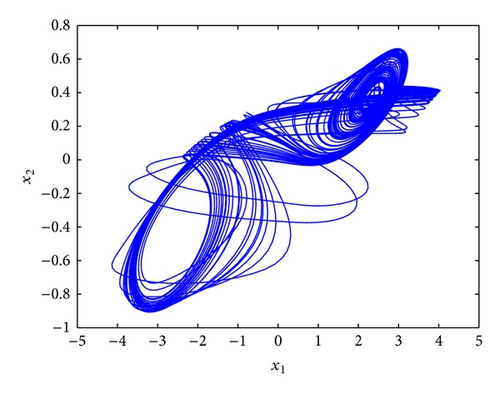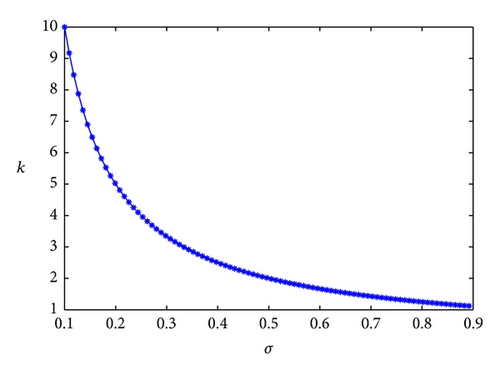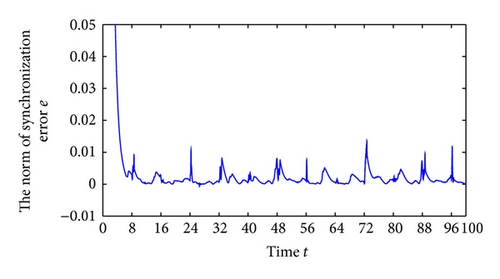Projective Lag Synchronization of Delayed Neural Networks Using Intermittent Linear State Feedback
Abstract
The problem of projective lag synchronization of coupled neural networks with time delay is investigated. By means of the Lyapunov stability theory, an intermittent controller is designed for achieving projective lag synchronization between two delayed neural networks systems. Numerical simulations on coupled Lu neural systems illustrate the effectiveness of the results.
1. Introduction
In the past few years, synchronization of neural networks has been extensively investigated due to their successful application in many areas, such as communication, modeling brain activity, signal processing, and combinatorial optimization. There are several different synchronization schemes including complete, lag, projective, generalized, phase, and anticipated synchronization [1–9]. In projective synchronization, the master-slave systems can be synchronized up to a scaling factor. Due to the potential applications in secure communication, projective synchronization has attracted increasing attention [10–13]. In [10], the authors study the projective synchronization for different chaotic delayed neural networks via sliding mode control approach. Function projective synchronization of two-cell Quantum-CNN chaotic oscillators using adaptive method is investigated in [11]. It is worth noting that the propagation delay may exist in remote communication systems. However, to the best of the authors’ knowledge, few results (if any) for the projective lag synchronization of neural networks with time delay have been reported in the literature.
In this paper, we will deal with the analysis issue for projective lag synchronization of neural networks with time delay by intermittent control approach. Recently, we have employed this method to stabilize and synchronize chaotic systems [14–16]. In this paper, by using Lyapunov stability theory and intermittent control technique, the intermittent controllers and corresponding parameter update rules are designed to obtain projective lag synchronization of neural networks. The rest of the paper is organized as follows. In Section 2, we formulate the problem of projective lag synchronization of coupled neural networks. In Section 3, a general scheme for the projective lag synchronization is presented. Numerical simulations are given in Section 4. Finally, conclusions are given in Section 5.
2. Problem Formulation and Preliminaries
3. Main Results
This section addresses the projective lag synchronization problem of coupled neural networks.
Theorem 2. Suppose that there exist constants α, the coupling strength k, time delay θ, and the functions H(t), K(t) such that
- (i)
C + CT − 2kI + g1I ≤ 0;
- (ii)
C + CT − g2I ≤ 0;
- (iii)
H(t) = −Af(y(t)) − Bg(y(t − τ)) + αAf(x(t − θ)) + αBg(x(t − τ − θ));
- (iv)
K(t) = −k(y(t) − αx(t − θ));
- (v)
g1σ − (1 − σ)g2 > 0.
Then, the projective lag synchronization error system (7) is globally exponentially stable, that is; the projective lag synchronization between the master system (2) and the slave system (4) under intermittent control (5) is achieved.
Proof. Consider the following Lyapunov function:
When nT ≤ t < nT + σT, the derivative of (9) with respect to time t along the trajectories of the first subsystem of the system (7) is calculated and estimated as follows:
(1) For 0 ≤ t < σT,
(2) For σT ≤ t < T,
(3) For T ≤ t < T + σT,
(4) For T + σT ≤ t < 2T,
(5) For nT ≤ t < nT + σT,
(6) For nT + σT ≤ t < (n + 1)T
This implies that the projective lag synchronization error system (7) is globally exponentially stable, and the following estimate holds:
This implies that the projective lag synchronization between the master system (2) and slave system (4) is achieved.
Let and , where , . If we replace the first condition in Theorem 2 with , , then Theorem 2 also can hold. In addition, one can obtain the following corollary from Theorem 2.
Corollary 3. Suppose that there exist positive scalars k and σ satisfying 0 < σ < 1 such that
Remark 4. If α = 1, it is clear that the lag synchronization between the system (2) and system (4) will occur.
Remark 5. It is clear that when the time delay vanishes, that is, θ = 0, we have e(t) = y(t) − αx(t), which implies that the projective synchronization between master system (2) without delay and system (4) without delay will occur.
Remark 6. From Corollary 3, one observes that the control strength k can be estimated as follows:
Note that C are determined only by the system itself, and σ is control parameter. Then, we can estimate the feasible region D of control parameters (k, σ) as follows:
4. Numerical Example
In this section, Lu neural oscillator [17] is presented as an example to verify the effectiveness of Theorem 2. The programs DDE23 in MATLAB are used to solve numerically the delay differential equations.
Example 1. Consider the Lu neural oscillator [17]
This model was investigated by Lu in [17] where it was shown to be chaotic, as shown in Figure 1. The corresponding slave system is given by
From Theorem 2, the controller can be obtained as follows:
Noting that λmax (C + CT) = 2, the feasible region of control parameters (k, σ) is D = {(k, σ)∣k < k* = −1/σ, 0 < σ < 1}, as shown in Figure 2. For numerical simulation, we select α = 2, θ = 0.01, σ = 0.1, and k = 10 and plot the norm of projective lag synchronization errors curve, as shown in Figure 3. As the time t goes to infinity, the projective lag synchronization error system is stable. Hence, the projective lag synchronization between system (27) and system (29) is achieved.



5. Conclusions
This paper addressed projective lag synchronization of coupled neural networks with time delay. Based on Lyapunov stability theory and adaptive control techniques, several criteria for projective lag synchronization of identical neural networks with time delay have been established. With the proposed method, the simulations of projective lag between coupled Lu systems have showed the effectiveness of theoretical result.
Acknowledgments
This publication was made possible by NPRP Grant no. NPRP 4-1162-1-181 from the Qatar National Research Fund (a member of Qatar Foundation). The statements made herein are solely the responsibility of the authors. This work was also supported by Natural Science Foundation of China (Grant no. 61374078), the Scientific and Technological Research Program of Chongqing Municipal Education Commission (Grant no. KJ121505), the Natural Science Foundation Project of Chongqing CSTC (Grant no. cstc2011jjA40005).




